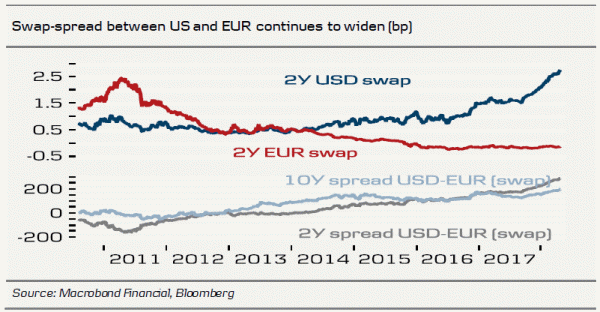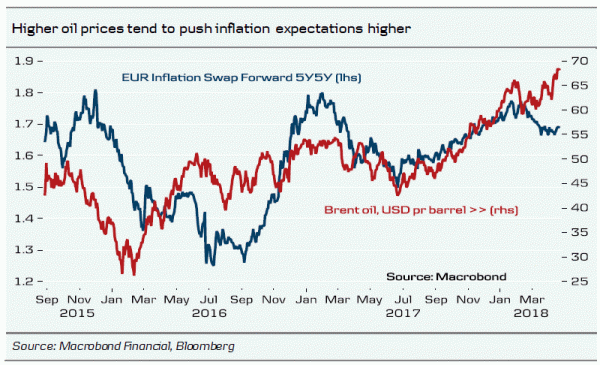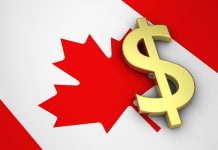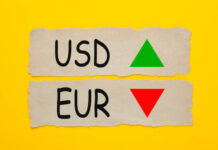The global bond sell-off that characterised the first six weeks of Q1 18 reversed in March and April and 10Y German yields are more or less back to the level at the beginning of the year, even after German yields rose again last week. The picture is somewhat different in the US. The combination of continued rate hikes from the Fed and higher inflation expectations has recently pushed 10Y US treasury yields back towards the 3.0% level. Hence, the 10Y spread between US and Germany/EUR has continued to widen. In addition, the spread in the short-end has widened further as the Fed continues to hike and as 3M USD Libor specifically has been pushed higher due to tighter USD liquidity.
We have become more certain that yields will not rise significantly in the euro zone in 2018
In the latest issue of Yield Outlook – Higher 10Y yields very much a 2019 story, 15 M arch, we argued that, in particular, Nordic/European 10Y rates and yields would not rise significantly in 2018 and that higher 10Y yields would be very much a 2019 story. Over the past month, we have become more confident in this view for two reasons.
1. Business cycle has peaked
It seems that the global business cycle is losing momentum. Last week, we published Research – Global business cycle moving lower, 19 April, which looks at the global business cycle.
We argue that there are clear signs that the global business cycle peaked in early 2018. Furthermore, our business cycle MacroScope models point to a further deceleration over coming quarters. Declining PMI levels across regions tend to cause some anxiety about the strength of the recovery and would normally put a cap on bond yields. We rarely see yields moving higher at the same time as business cycle indicators such as the PMIs move lower.
2. ECB will not hike before late 2019
Second, we doubt that we will see a change in rhetoric from the ECB in 2018. Last week, we changed our forecast for the ECB (see ECB Preview – Not on Draghi’s watch, 20 April) and we now forecast that the ECB will not hike before December 2019, when Mario Draghi and other ‘dovish’ members have left the ECB. Earlier we had p encilled in a first rate hike in Q2 19. If we are correct that the European business cycle is weakening, it should further diminish the risk of a change in rhetoric from the ECB. Indeed, over the weekend, Draghi said that ‘economic indicators…suggest that the growth cy cle has p eaked’.
Regarding central bank rhetoric, note also that Bank of England Governor Mark Carney struck a dovish tone in an interview last week, stating that a few rate hikes may be warranted over the next few years, thus essentially questioning whether a May hike is a done deal after all.
We also expect a soft stance from the Riksbank this week, as we expect the Riksbank to postpone the first rate hike to 2019 (see Reading the Markets Sweden, 20 April.
Commodity prices are the risk factor for global fixed income markets
In our view, the main risk factor for global fixed income markets over the next two quarters is the global commodity market. The sanctions against Russia could still push some metal prices higher even after aluminium and nickel prices jumped recently.
In the oil market, it is noteworthy that the supply and demand balance has improved in 2018 (lower stocks). However, oil prices, in particular, could be pushed higher if Donald Trump ‘s administration decides to take a tougher stance on Iran. However, it would be a supply-driven oil price, which the ECB should be less eager to react on but still there is a close correlation between inflation expectations and oil prices. Hence, higher oil prices, everything being equal, tend to push nominal rates and yields higher.
Fed set to raise above the 2.75% long-run dot
We continue to see a further widening of the two-year spread between USD and EUR rates. We expect the Fed to hike three times this year and next. Importantly, we still expect the Fed to raise the Fed funds rate above the longer run dot of 2.75% (the Fed’s estimate of the natural rate of interest when the economy is normalised) in coming years.
Hence, we continue to disagree with markets, as the markets believe the Fed will hike less than twice in 2019. We believe the Fed will continue to hit the brakes, as fiscal policy has become more expansionary and the output gap has nearly closed.
ECB trying to convince the market we will see no taper tantrum
It is notable that the ECB is eager to communicate to the market that we should not see a ‘tap er tantrum’ in the eurozone bond market this year (surge in US yields in 2013 after the Federal reserve announced lower monthly bond p urchases). The ECB argues that the ‘free float’ of German bonds, in p articular, is very limited and close to 10%, as a large p art is own by the ECB itself and other central banks. This is very different from the US treasury market in 2013. That the ECB has a large stock means that the impact of the ECB ending the QE programme should be small, as, in particular, the reinvestment flow of coupons and matured bonds will be sizeable over the near future. For more on this subject, see among this speech from ECB member Benoît Coeuré from 23 February.
Our fixed income view – higher yields mainly a 2019 story
We have lowered our 12M forecast for German 10Y yields slightly from 1.20% to 1.1% due to the change in the ECB deposit rate forecast. We also continue to see a subdued inflation picture in the eurozone and a weaker European business cycle in 2018. We also expect the ECB ending the QE programme this year to have only a small effect on the bond markets. Hence, we continue to see most of the expected rise in yields being in 2019.
We continue to expect a steeper 2Y10Y German yield curve. The ECB still maintains a relatively tight grip on the short end of the curve, especially with the first ECB rate hikes expected late in 2019. However, this is not the case for the 10Y segment of the curve, which we still expect to be pushed by higher US yields in 2019. We have 1.1% (previously 1.2%) and 3.3% (unchanged) 12M forecasts for the 10Y German Bund yield and the 10Y US Treasury yield, respectively.
The boost to fiscal policy in the US and the possible pricing of more rate hikes in the US are the main reasons we still see upside for US 10Y yields. In our view, the latter will have a tendency also to push long yields in the eurozone higher.















